Global Business Logistics: Analyzing Impact on Enterprises
VerifiedAdded on 2023/06/08
|10
|3852
|142
Report
AI Summary
This report analyzes the impact of key logistics challenges, including fuel costs, digitalization, and government regulations, on specific enterprises within the Australian logistics and transportation industry. It examines how these challenges affect organizations like Direct Drive Logistics, AXIT Connecting Logistics, and DHL Supply Chain, detailing the strategies they adopt to mitigate negative impacts and ensure continued profitability and stability. The analysis covers the implications of fluctuating fuel costs, the necessity of digitalization for competitive advantage, and the pressures of meeting regulatory requirements. Strategies discussed include restructuring business operations, adopting larger bulk shipments, developing new business models with digital platforms and advanced analytics, and focusing on robust internal digital foundations. The report emphasizes the importance of adapting to technological advancements and regulatory changes to maintain operational efficiency and customer satisfaction in the evolving logistics landscape. Desklib provides past papers and solved assignments for students.
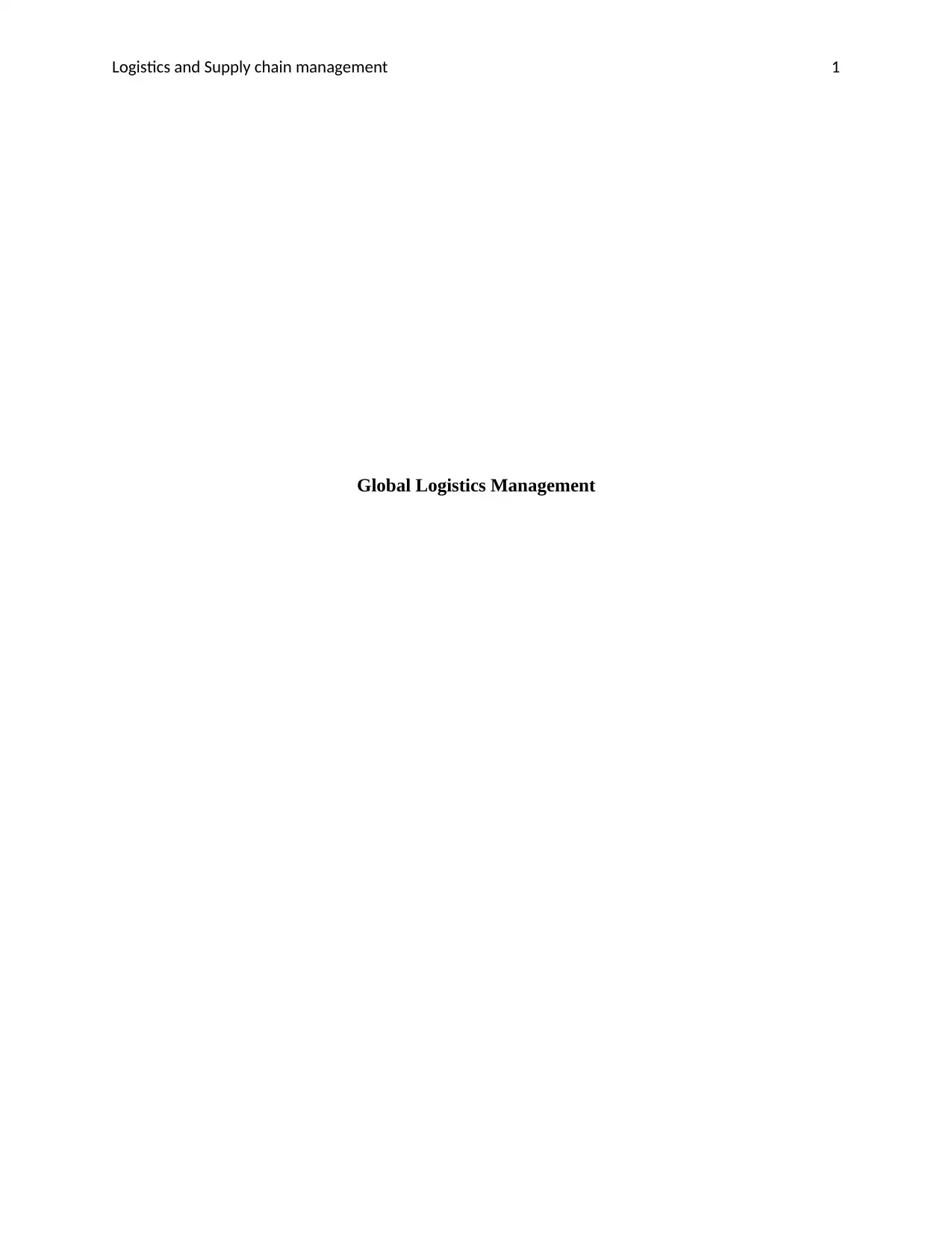
Logistics and Supply chain management 1
Global Logistics Management
Global Logistics Management
Paraphrase This Document
Need a fresh take? Get an instant paraphrase of this document with our AI Paraphraser
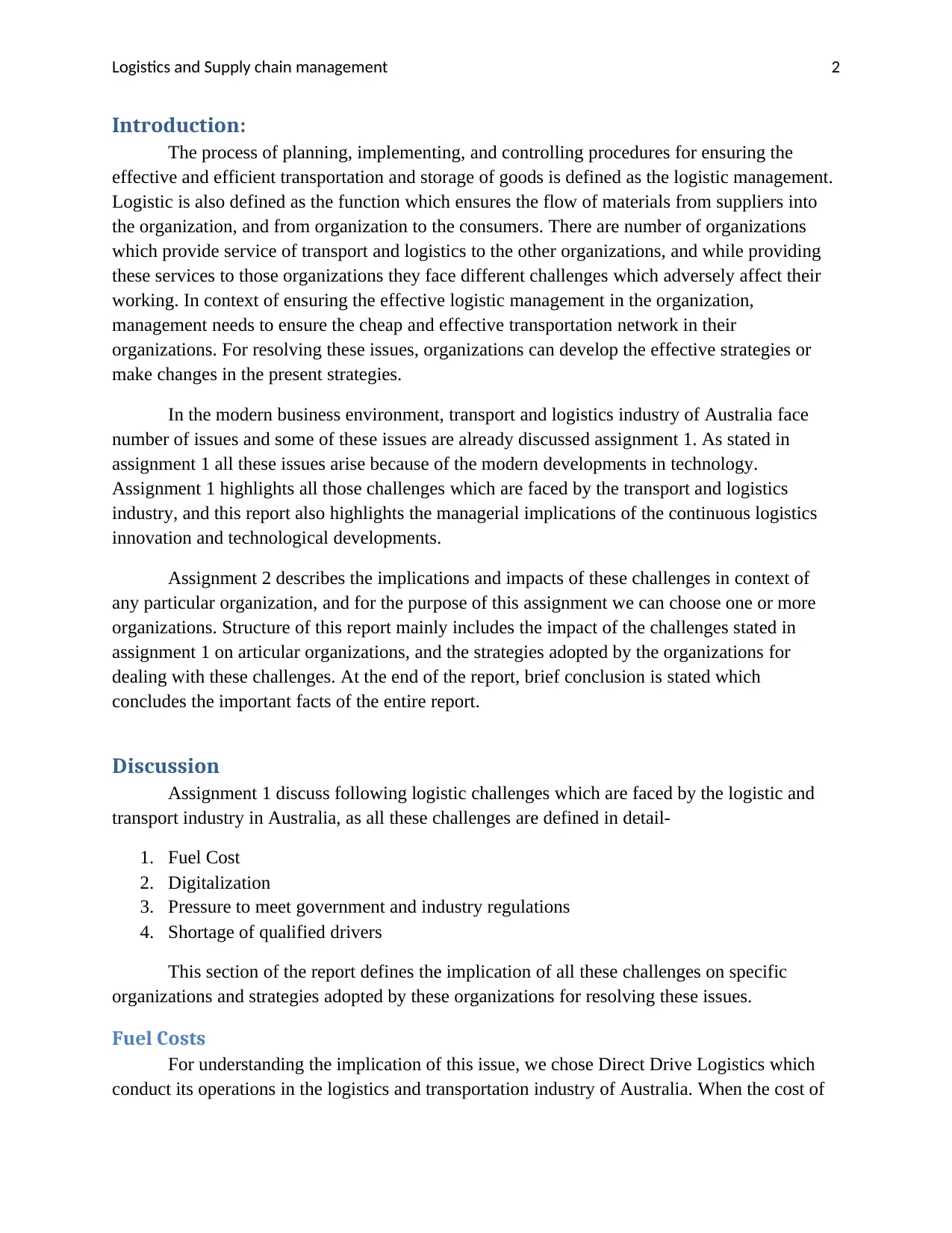
Logistics and Supply chain management 2
Introduction:
The process of planning, implementing, and controlling procedures for ensuring the
effective and efficient transportation and storage of goods is defined as the logistic management.
Logistic is also defined as the function which ensures the flow of materials from suppliers into
the organization, and from organization to the consumers. There are number of organizations
which provide service of transport and logistics to the other organizations, and while providing
these services to those organizations they face different challenges which adversely affect their
working. In context of ensuring the effective logistic management in the organization,
management needs to ensure the cheap and effective transportation network in their
organizations. For resolving these issues, organizations can develop the effective strategies or
make changes in the present strategies.
In the modern business environment, transport and logistics industry of Australia face
number of issues and some of these issues are already discussed assignment 1. As stated in
assignment 1 all these issues arise because of the modern developments in technology.
Assignment 1 highlights all those challenges which are faced by the transport and logistics
industry, and this report also highlights the managerial implications of the continuous logistics
innovation and technological developments.
Assignment 2 describes the implications and impacts of these challenges in context of
any particular organization, and for the purpose of this assignment we can choose one or more
organizations. Structure of this report mainly includes the impact of the challenges stated in
assignment 1 on articular organizations, and the strategies adopted by the organizations for
dealing with these challenges. At the end of the report, brief conclusion is stated which
concludes the important facts of the entire report.
Discussion
Assignment 1 discuss following logistic challenges which are faced by the logistic and
transport industry in Australia, as all these challenges are defined in detail-
1. Fuel Cost
2. Digitalization
3. Pressure to meet government and industry regulations
4. Shortage of qualified drivers
This section of the report defines the implication of all these challenges on specific
organizations and strategies adopted by these organizations for resolving these issues.
Fuel Costs
For understanding the implication of this issue, we chose Direct Drive Logistics which
conduct its operations in the logistics and transportation industry of Australia. When the cost of
Introduction:
The process of planning, implementing, and controlling procedures for ensuring the
effective and efficient transportation and storage of goods is defined as the logistic management.
Logistic is also defined as the function which ensures the flow of materials from suppliers into
the organization, and from organization to the consumers. There are number of organizations
which provide service of transport and logistics to the other organizations, and while providing
these services to those organizations they face different challenges which adversely affect their
working. In context of ensuring the effective logistic management in the organization,
management needs to ensure the cheap and effective transportation network in their
organizations. For resolving these issues, organizations can develop the effective strategies or
make changes in the present strategies.
In the modern business environment, transport and logistics industry of Australia face
number of issues and some of these issues are already discussed assignment 1. As stated in
assignment 1 all these issues arise because of the modern developments in technology.
Assignment 1 highlights all those challenges which are faced by the transport and logistics
industry, and this report also highlights the managerial implications of the continuous logistics
innovation and technological developments.
Assignment 2 describes the implications and impacts of these challenges in context of
any particular organization, and for the purpose of this assignment we can choose one or more
organizations. Structure of this report mainly includes the impact of the challenges stated in
assignment 1 on articular organizations, and the strategies adopted by the organizations for
dealing with these challenges. At the end of the report, brief conclusion is stated which
concludes the important facts of the entire report.
Discussion
Assignment 1 discuss following logistic challenges which are faced by the logistic and
transport industry in Australia, as all these challenges are defined in detail-
1. Fuel Cost
2. Digitalization
3. Pressure to meet government and industry regulations
4. Shortage of qualified drivers
This section of the report defines the implication of all these challenges on specific
organizations and strategies adopted by these organizations for resolving these issues.
Fuel Costs
For understanding the implication of this issue, we chose Direct Drive Logistics which
conduct its operations in the logistics and transportation industry of Australia. When the cost of
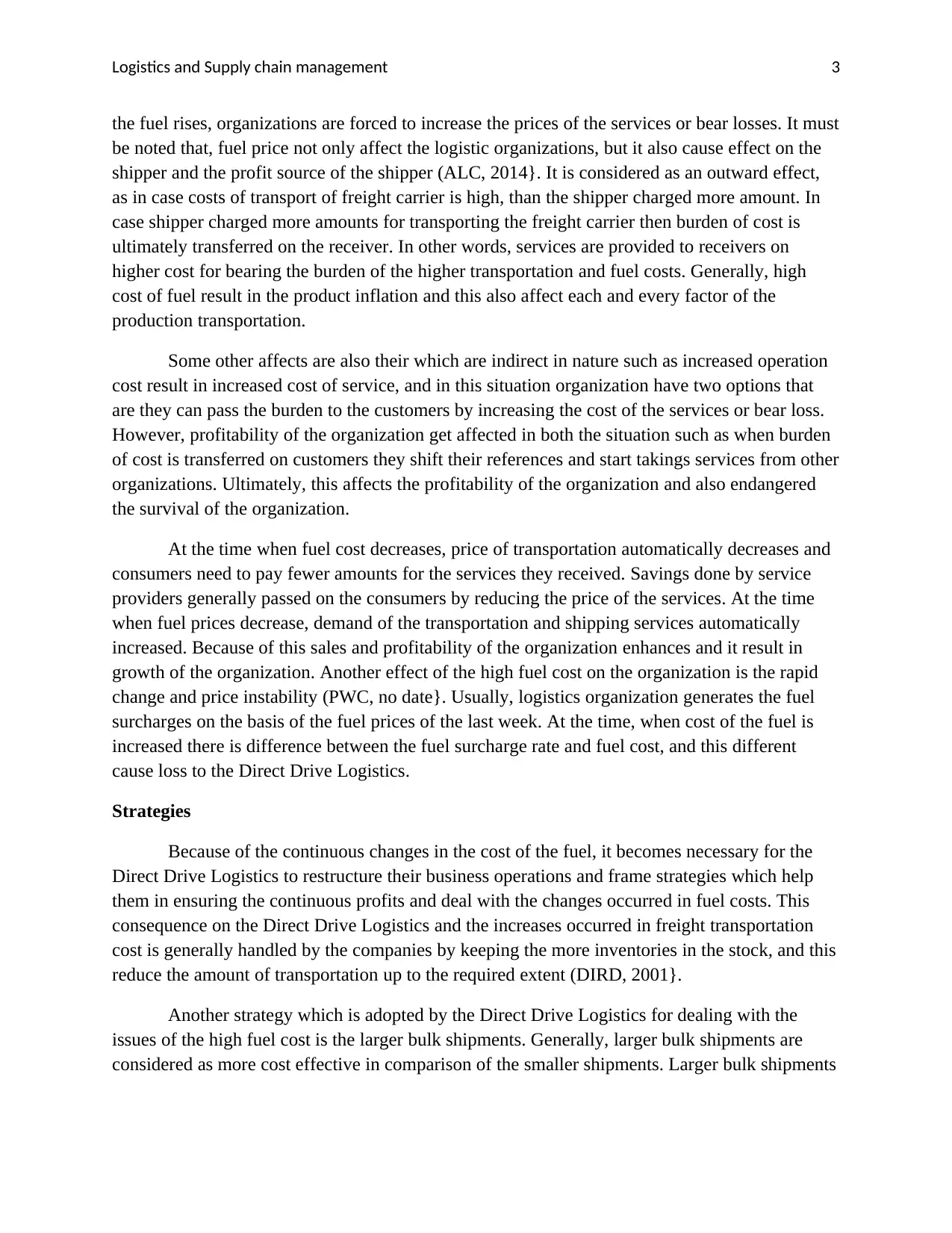
Logistics and Supply chain management 3
the fuel rises, organizations are forced to increase the prices of the services or bear losses. It must
be noted that, fuel price not only affect the logistic organizations, but it also cause effect on the
shipper and the profit source of the shipper (ALC, 2014}. It is considered as an outward effect,
as in case costs of transport of freight carrier is high, than the shipper charged more amount. In
case shipper charged more amounts for transporting the freight carrier then burden of cost is
ultimately transferred on the receiver. In other words, services are provided to receivers on
higher cost for bearing the burden of the higher transportation and fuel costs. Generally, high
cost of fuel result in the product inflation and this also affect each and every factor of the
production transportation.
Some other affects are also their which are indirect in nature such as increased operation
cost result in increased cost of service, and in this situation organization have two options that
are they can pass the burden to the customers by increasing the cost of the services or bear loss.
However, profitability of the organization get affected in both the situation such as when burden
of cost is transferred on customers they shift their references and start takings services from other
organizations. Ultimately, this affects the profitability of the organization and also endangered
the survival of the organization.
At the time when fuel cost decreases, price of transportation automatically decreases and
consumers need to pay fewer amounts for the services they received. Savings done by service
providers generally passed on the consumers by reducing the price of the services. At the time
when fuel prices decrease, demand of the transportation and shipping services automatically
increased. Because of this sales and profitability of the organization enhances and it result in
growth of the organization. Another effect of the high fuel cost on the organization is the rapid
change and price instability (PWC, no date}. Usually, logistics organization generates the fuel
surcharges on the basis of the fuel prices of the last week. At the time, when cost of the fuel is
increased there is difference between the fuel surcharge rate and fuel cost, and this different
cause loss to the Direct Drive Logistics.
Strategies
Because of the continuous changes in the cost of the fuel, it becomes necessary for the
Direct Drive Logistics to restructure their business operations and frame strategies which help
them in ensuring the continuous profits and deal with the changes occurred in fuel costs. This
consequence on the Direct Drive Logistics and the increases occurred in freight transportation
cost is generally handled by the companies by keeping the more inventories in the stock, and this
reduce the amount of transportation up to the required extent (DIRD, 2001}.
Another strategy which is adopted by the Direct Drive Logistics for dealing with the
issues of the high fuel cost is the larger bulk shipments. Generally, larger bulk shipments are
considered as more cost effective in comparison of the smaller shipments. Larger bulk shipments
the fuel rises, organizations are forced to increase the prices of the services or bear losses. It must
be noted that, fuel price not only affect the logistic organizations, but it also cause effect on the
shipper and the profit source of the shipper (ALC, 2014}. It is considered as an outward effect,
as in case costs of transport of freight carrier is high, than the shipper charged more amount. In
case shipper charged more amounts for transporting the freight carrier then burden of cost is
ultimately transferred on the receiver. In other words, services are provided to receivers on
higher cost for bearing the burden of the higher transportation and fuel costs. Generally, high
cost of fuel result in the product inflation and this also affect each and every factor of the
production transportation.
Some other affects are also their which are indirect in nature such as increased operation
cost result in increased cost of service, and in this situation organization have two options that
are they can pass the burden to the customers by increasing the cost of the services or bear loss.
However, profitability of the organization get affected in both the situation such as when burden
of cost is transferred on customers they shift their references and start takings services from other
organizations. Ultimately, this affects the profitability of the organization and also endangered
the survival of the organization.
At the time when fuel cost decreases, price of transportation automatically decreases and
consumers need to pay fewer amounts for the services they received. Savings done by service
providers generally passed on the consumers by reducing the price of the services. At the time
when fuel prices decrease, demand of the transportation and shipping services automatically
increased. Because of this sales and profitability of the organization enhances and it result in
growth of the organization. Another effect of the high fuel cost on the organization is the rapid
change and price instability (PWC, no date}. Usually, logistics organization generates the fuel
surcharges on the basis of the fuel prices of the last week. At the time, when cost of the fuel is
increased there is difference between the fuel surcharge rate and fuel cost, and this different
cause loss to the Direct Drive Logistics.
Strategies
Because of the continuous changes in the cost of the fuel, it becomes necessary for the
Direct Drive Logistics to restructure their business operations and frame strategies which help
them in ensuring the continuous profits and deal with the changes occurred in fuel costs. This
consequence on the Direct Drive Logistics and the increases occurred in freight transportation
cost is generally handled by the companies by keeping the more inventories in the stock, and this
reduce the amount of transportation up to the required extent (DIRD, 2001}.
Another strategy which is adopted by the Direct Drive Logistics for dealing with the
issues of the high fuel cost is the larger bulk shipments. Generally, larger bulk shipments are
considered as more cost effective in comparison of the smaller shipments. Larger bulk shipments
⊘ This is a preview!⊘
Do you want full access?
Subscribe today to unlock all pages.

Trusted by 1+ million students worldwide
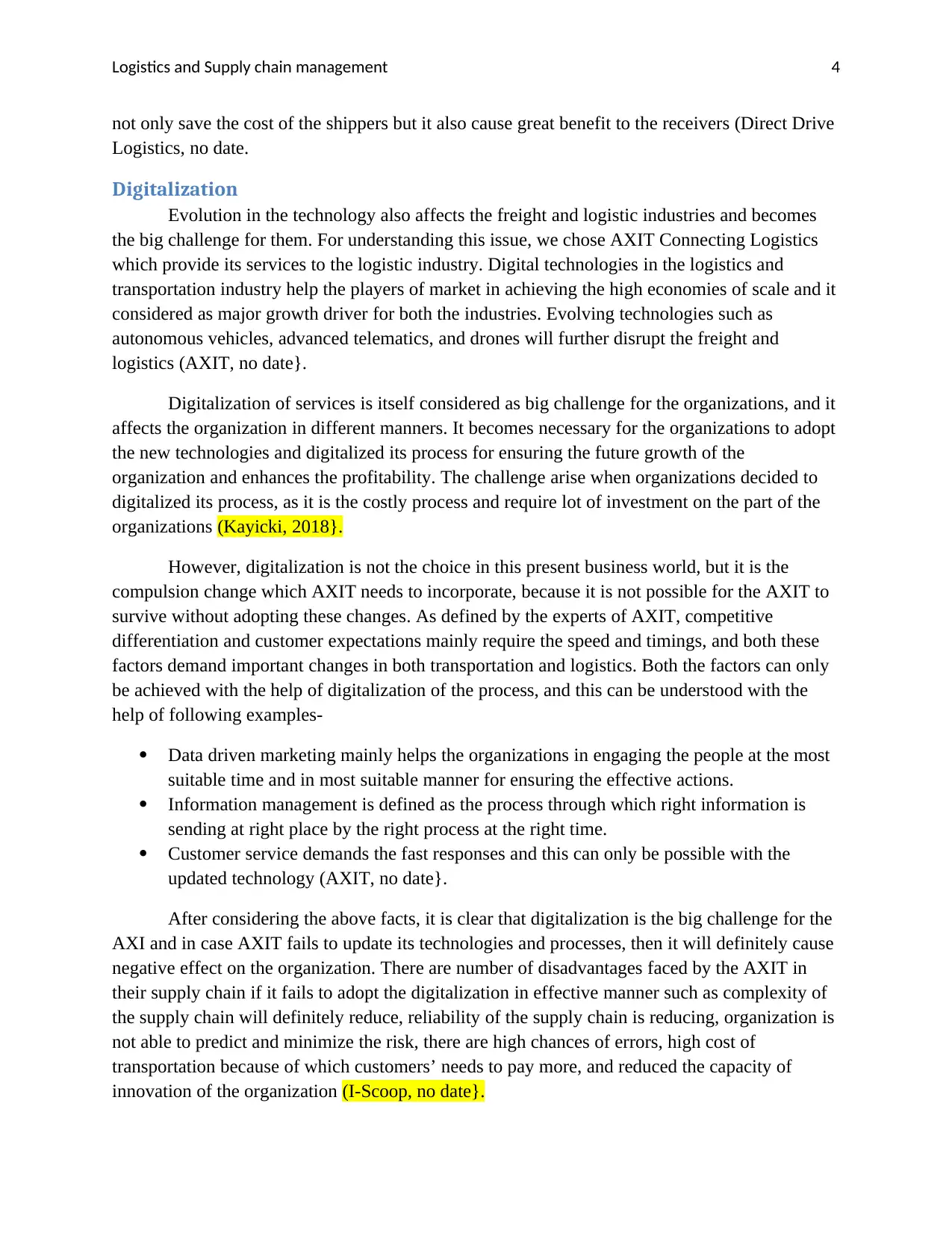
Logistics and Supply chain management 4
not only save the cost of the shippers but it also cause great benefit to the receivers (Direct Drive
Logistics, no date.
Digitalization
Evolution in the technology also affects the freight and logistic industries and becomes
the big challenge for them. For understanding this issue, we chose AXIT Connecting Logistics
which provide its services to the logistic industry. Digital technologies in the logistics and
transportation industry help the players of market in achieving the high economies of scale and it
considered as major growth driver for both the industries. Evolving technologies such as
autonomous vehicles, advanced telematics, and drones will further disrupt the freight and
logistics (AXIT, no date}.
Digitalization of services is itself considered as big challenge for the organizations, and it
affects the organization in different manners. It becomes necessary for the organizations to adopt
the new technologies and digitalized its process for ensuring the future growth of the
organization and enhances the profitability. The challenge arise when organizations decided to
digitalized its process, as it is the costly process and require lot of investment on the part of the
organizations (Kayicki, 2018}.
However, digitalization is not the choice in this present business world, but it is the
compulsion change which AXIT needs to incorporate, because it is not possible for the AXIT to
survive without adopting these changes. As defined by the experts of AXIT, competitive
differentiation and customer expectations mainly require the speed and timings, and both these
factors demand important changes in both transportation and logistics. Both the factors can only
be achieved with the help of digitalization of the process, and this can be understood with the
help of following examples-
Data driven marketing mainly helps the organizations in engaging the people at the most
suitable time and in most suitable manner for ensuring the effective actions.
Information management is defined as the process through which right information is
sending at right place by the right process at the right time.
Customer service demands the fast responses and this can only be possible with the
updated technology (AXIT, no date}.
After considering the above facts, it is clear that digitalization is the big challenge for the
AXI and in case AXIT fails to update its technologies and processes, then it will definitely cause
negative effect on the organization. There are number of disadvantages faced by the AXIT in
their supply chain if it fails to adopt the digitalization in effective manner such as complexity of
the supply chain will definitely reduce, reliability of the supply chain is reducing, organization is
not able to predict and minimize the risk, there are high chances of errors, high cost of
transportation because of which customers’ needs to pay more, and reduced the capacity of
innovation of the organization (I-Scoop, no date}.
not only save the cost of the shippers but it also cause great benefit to the receivers (Direct Drive
Logistics, no date.
Digitalization
Evolution in the technology also affects the freight and logistic industries and becomes
the big challenge for them. For understanding this issue, we chose AXIT Connecting Logistics
which provide its services to the logistic industry. Digital technologies in the logistics and
transportation industry help the players of market in achieving the high economies of scale and it
considered as major growth driver for both the industries. Evolving technologies such as
autonomous vehicles, advanced telematics, and drones will further disrupt the freight and
logistics (AXIT, no date}.
Digitalization of services is itself considered as big challenge for the organizations, and it
affects the organization in different manners. It becomes necessary for the organizations to adopt
the new technologies and digitalized its process for ensuring the future growth of the
organization and enhances the profitability. The challenge arise when organizations decided to
digitalized its process, as it is the costly process and require lot of investment on the part of the
organizations (Kayicki, 2018}.
However, digitalization is not the choice in this present business world, but it is the
compulsion change which AXIT needs to incorporate, because it is not possible for the AXIT to
survive without adopting these changes. As defined by the experts of AXIT, competitive
differentiation and customer expectations mainly require the speed and timings, and both these
factors demand important changes in both transportation and logistics. Both the factors can only
be achieved with the help of digitalization of the process, and this can be understood with the
help of following examples-
Data driven marketing mainly helps the organizations in engaging the people at the most
suitable time and in most suitable manner for ensuring the effective actions.
Information management is defined as the process through which right information is
sending at right place by the right process at the right time.
Customer service demands the fast responses and this can only be possible with the
updated technology (AXIT, no date}.
After considering the above facts, it is clear that digitalization is the big challenge for the
AXI and in case AXIT fails to update its technologies and processes, then it will definitely cause
negative effect on the organization. There are number of disadvantages faced by the AXIT in
their supply chain if it fails to adopt the digitalization in effective manner such as complexity of
the supply chain will definitely reduce, reliability of the supply chain is reducing, organization is
not able to predict and minimize the risk, there are high chances of errors, high cost of
transportation because of which customers’ needs to pay more, and reduced the capacity of
innovation of the organization (I-Scoop, no date}.
Paraphrase This Document
Need a fresh take? Get an instant paraphrase of this document with our AI Paraphraser
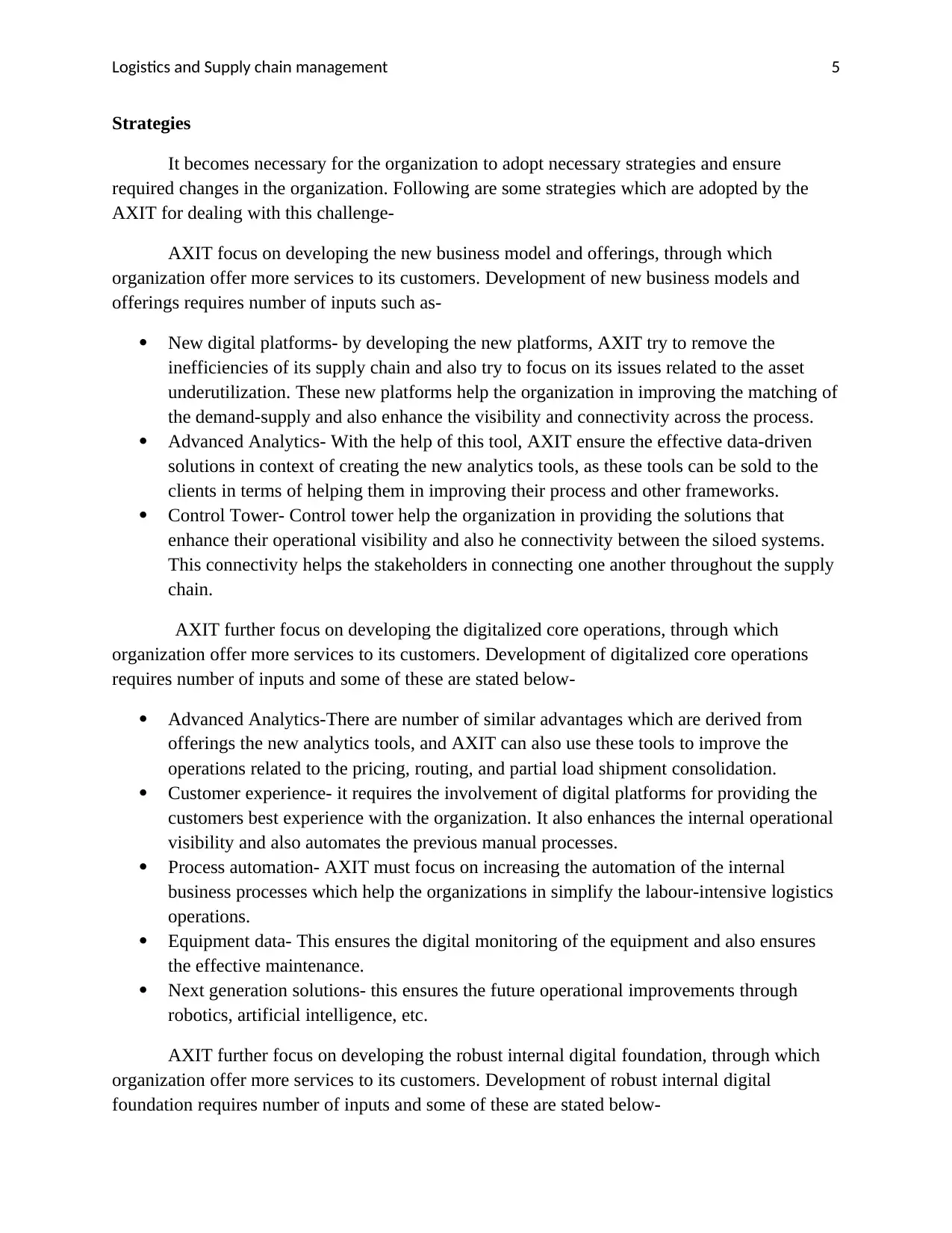
Logistics and Supply chain management 5
Strategies
It becomes necessary for the organization to adopt necessary strategies and ensure
required changes in the organization. Following are some strategies which are adopted by the
AXIT for dealing with this challenge-
AXIT focus on developing the new business model and offerings, through which
organization offer more services to its customers. Development of new business models and
offerings requires number of inputs such as-
New digital platforms- by developing the new platforms, AXIT try to remove the
inefficiencies of its supply chain and also try to focus on its issues related to the asset
underutilization. These new platforms help the organization in improving the matching of
the demand-supply and also enhance the visibility and connectivity across the process.
Advanced Analytics- With the help of this tool, AXIT ensure the effective data-driven
solutions in context of creating the new analytics tools, as these tools can be sold to the
clients in terms of helping them in improving their process and other frameworks.
Control Tower- Control tower help the organization in providing the solutions that
enhance their operational visibility and also he connectivity between the siloed systems.
This connectivity helps the stakeholders in connecting one another throughout the supply
chain.
AXIT further focus on developing the digitalized core operations, through which
organization offer more services to its customers. Development of digitalized core operations
requires number of inputs and some of these are stated below-
Advanced Analytics-There are number of similar advantages which are derived from
offerings the new analytics tools, and AXIT can also use these tools to improve the
operations related to the pricing, routing, and partial load shipment consolidation.
Customer experience- it requires the involvement of digital platforms for providing the
customers best experience with the organization. It also enhances the internal operational
visibility and also automates the previous manual processes.
Process automation- AXIT must focus on increasing the automation of the internal
business processes which help the organizations in simplify the labour-intensive logistics
operations.
Equipment data- This ensures the digital monitoring of the equipment and also ensures
the effective maintenance.
Next generation solutions- this ensures the future operational improvements through
robotics, artificial intelligence, etc.
AXIT further focus on developing the robust internal digital foundation, through which
organization offer more services to its customers. Development of robust internal digital
foundation requires number of inputs and some of these are stated below-
Strategies
It becomes necessary for the organization to adopt necessary strategies and ensure
required changes in the organization. Following are some strategies which are adopted by the
AXIT for dealing with this challenge-
AXIT focus on developing the new business model and offerings, through which
organization offer more services to its customers. Development of new business models and
offerings requires number of inputs such as-
New digital platforms- by developing the new platforms, AXIT try to remove the
inefficiencies of its supply chain and also try to focus on its issues related to the asset
underutilization. These new platforms help the organization in improving the matching of
the demand-supply and also enhance the visibility and connectivity across the process.
Advanced Analytics- With the help of this tool, AXIT ensure the effective data-driven
solutions in context of creating the new analytics tools, as these tools can be sold to the
clients in terms of helping them in improving their process and other frameworks.
Control Tower- Control tower help the organization in providing the solutions that
enhance their operational visibility and also he connectivity between the siloed systems.
This connectivity helps the stakeholders in connecting one another throughout the supply
chain.
AXIT further focus on developing the digitalized core operations, through which
organization offer more services to its customers. Development of digitalized core operations
requires number of inputs and some of these are stated below-
Advanced Analytics-There are number of similar advantages which are derived from
offerings the new analytics tools, and AXIT can also use these tools to improve the
operations related to the pricing, routing, and partial load shipment consolidation.
Customer experience- it requires the involvement of digital platforms for providing the
customers best experience with the organization. It also enhances the internal operational
visibility and also automates the previous manual processes.
Process automation- AXIT must focus on increasing the automation of the internal
business processes which help the organizations in simplify the labour-intensive logistics
operations.
Equipment data- This ensures the digital monitoring of the equipment and also ensures
the effective maintenance.
Next generation solutions- this ensures the future operational improvements through
robotics, artificial intelligence, etc.
AXIT further focus on developing the robust internal digital foundation, through which
organization offer more services to its customers. Development of robust internal digital
foundation requires number of inputs and some of these are stated below-
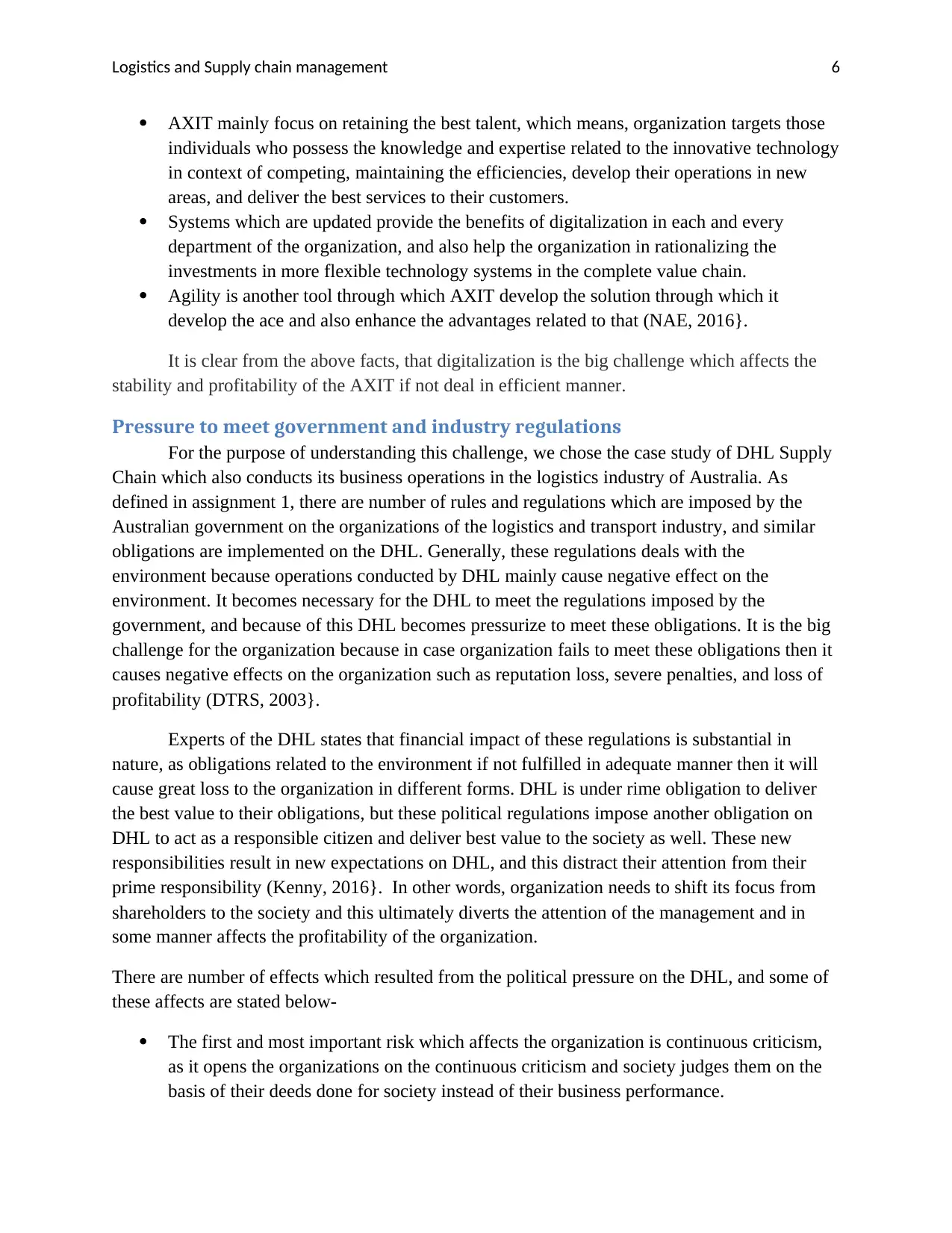
Logistics and Supply chain management 6
AXIT mainly focus on retaining the best talent, which means, organization targets those
individuals who possess the knowledge and expertise related to the innovative technology
in context of competing, maintaining the efficiencies, develop their operations in new
areas, and deliver the best services to their customers.
Systems which are updated provide the benefits of digitalization in each and every
department of the organization, and also help the organization in rationalizing the
investments in more flexible technology systems in the complete value chain.
Agility is another tool through which AXIT develop the solution through which it
develop the ace and also enhance the advantages related to that (NAE, 2016}.
It is clear from the above facts, that digitalization is the big challenge which affects the
stability and profitability of the AXIT if not deal in efficient manner.
Pressure to meet government and industry regulations
For the purpose of understanding this challenge, we chose the case study of DHL Supply
Chain which also conducts its business operations in the logistics industry of Australia. As
defined in assignment 1, there are number of rules and regulations which are imposed by the
Australian government on the organizations of the logistics and transport industry, and similar
obligations are implemented on the DHL. Generally, these regulations deals with the
environment because operations conducted by DHL mainly cause negative effect on the
environment. It becomes necessary for the DHL to meet the regulations imposed by the
government, and because of this DHL becomes pressurize to meet these obligations. It is the big
challenge for the organization because in case organization fails to meet these obligations then it
causes negative effects on the organization such as reputation loss, severe penalties, and loss of
profitability (DTRS, 2003}.
Experts of the DHL states that financial impact of these regulations is substantial in
nature, as obligations related to the environment if not fulfilled in adequate manner then it will
cause great loss to the organization in different forms. DHL is under rime obligation to deliver
the best value to their obligations, but these political regulations impose another obligation on
DHL to act as a responsible citizen and deliver best value to the society as well. These new
responsibilities result in new expectations on DHL, and this distract their attention from their
prime responsibility (Kenny, 2016}. In other words, organization needs to shift its focus from
shareholders to the society and this ultimately diverts the attention of the management and in
some manner affects the profitability of the organization.
There are number of effects which resulted from the political pressure on the DHL, and some of
these affects are stated below-
The first and most important risk which affects the organization is continuous criticism,
as it opens the organizations on the continuous criticism and society judges them on the
basis of their deeds done for society instead of their business performance.
AXIT mainly focus on retaining the best talent, which means, organization targets those
individuals who possess the knowledge and expertise related to the innovative technology
in context of competing, maintaining the efficiencies, develop their operations in new
areas, and deliver the best services to their customers.
Systems which are updated provide the benefits of digitalization in each and every
department of the organization, and also help the organization in rationalizing the
investments in more flexible technology systems in the complete value chain.
Agility is another tool through which AXIT develop the solution through which it
develop the ace and also enhance the advantages related to that (NAE, 2016}.
It is clear from the above facts, that digitalization is the big challenge which affects the
stability and profitability of the AXIT if not deal in efficient manner.
Pressure to meet government and industry regulations
For the purpose of understanding this challenge, we chose the case study of DHL Supply
Chain which also conducts its business operations in the logistics industry of Australia. As
defined in assignment 1, there are number of rules and regulations which are imposed by the
Australian government on the organizations of the logistics and transport industry, and similar
obligations are implemented on the DHL. Generally, these regulations deals with the
environment because operations conducted by DHL mainly cause negative effect on the
environment. It becomes necessary for the DHL to meet the regulations imposed by the
government, and because of this DHL becomes pressurize to meet these obligations. It is the big
challenge for the organization because in case organization fails to meet these obligations then it
causes negative effects on the organization such as reputation loss, severe penalties, and loss of
profitability (DTRS, 2003}.
Experts of the DHL states that financial impact of these regulations is substantial in
nature, as obligations related to the environment if not fulfilled in adequate manner then it will
cause great loss to the organization in different forms. DHL is under rime obligation to deliver
the best value to their obligations, but these political regulations impose another obligation on
DHL to act as a responsible citizen and deliver best value to the society as well. These new
responsibilities result in new expectations on DHL, and this distract their attention from their
prime responsibility (Kenny, 2016}. In other words, organization needs to shift its focus from
shareholders to the society and this ultimately diverts the attention of the management and in
some manner affects the profitability of the organization.
There are number of effects which resulted from the political pressure on the DHL, and some of
these affects are stated below-
The first and most important risk which affects the organization is continuous criticism,
as it opens the organizations on the continuous criticism and society judges them on the
basis of their deeds done for society instead of their business performance.
⊘ This is a preview!⊘
Do you want full access?
Subscribe today to unlock all pages.

Trusted by 1+ million students worldwide
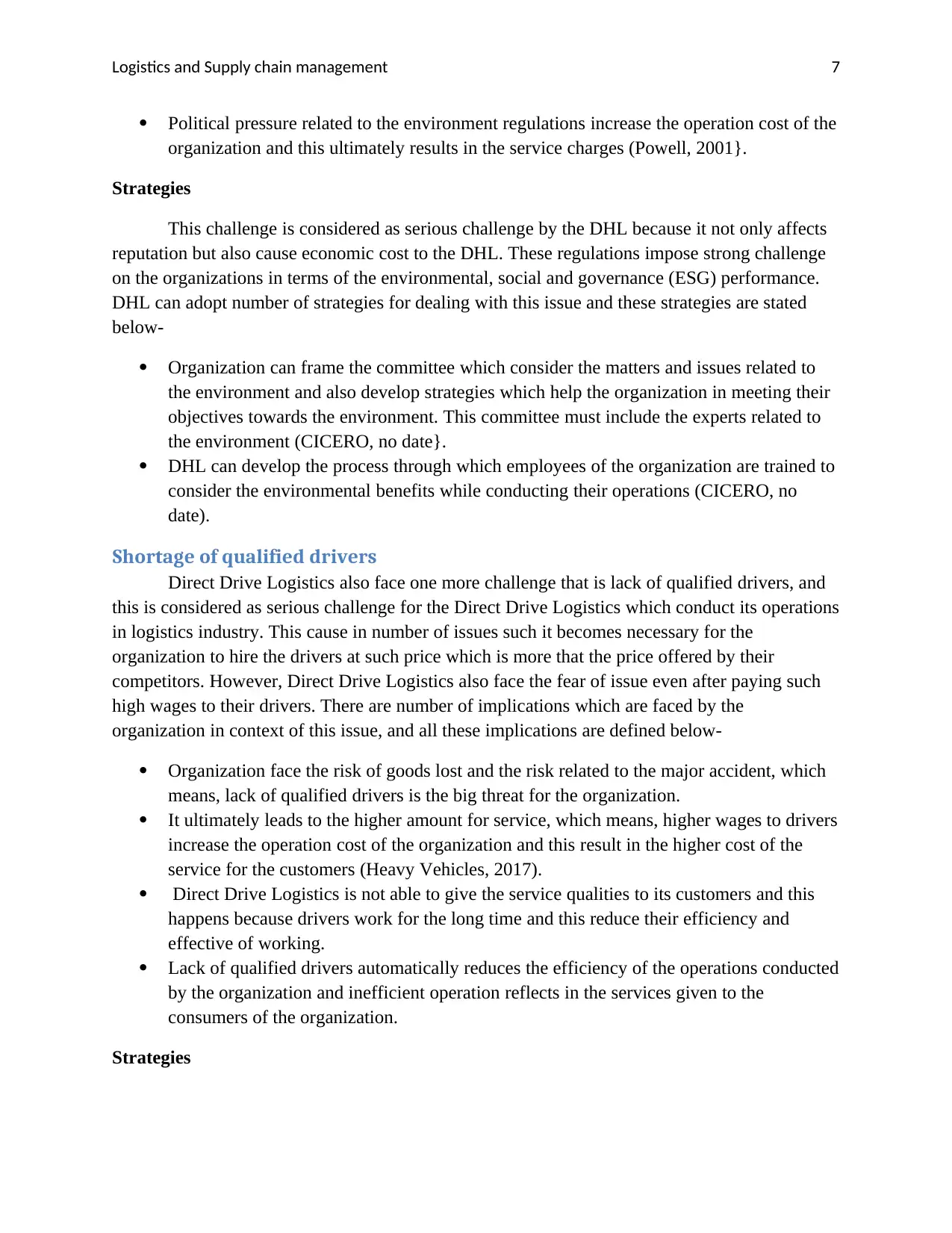
Logistics and Supply chain management 7
Political pressure related to the environment regulations increase the operation cost of the
organization and this ultimately results in the service charges (Powell, 2001}.
Strategies
This challenge is considered as serious challenge by the DHL because it not only affects
reputation but also cause economic cost to the DHL. These regulations impose strong challenge
on the organizations in terms of the environmental, social and governance (ESG) performance.
DHL can adopt number of strategies for dealing with this issue and these strategies are stated
below-
Organization can frame the committee which consider the matters and issues related to
the environment and also develop strategies which help the organization in meeting their
objectives towards the environment. This committee must include the experts related to
the environment (CICERO, no date}.
DHL can develop the process through which employees of the organization are trained to
consider the environmental benefits while conducting their operations (CICERO, no
date).
Shortage of qualified drivers
Direct Drive Logistics also face one more challenge that is lack of qualified drivers, and
this is considered as serious challenge for the Direct Drive Logistics which conduct its operations
in logistics industry. This cause in number of issues such it becomes necessary for the
organization to hire the drivers at such price which is more that the price offered by their
competitors. However, Direct Drive Logistics also face the fear of issue even after paying such
high wages to their drivers. There are number of implications which are faced by the
organization in context of this issue, and all these implications are defined below-
Organization face the risk of goods lost and the risk related to the major accident, which
means, lack of qualified drivers is the big threat for the organization.
It ultimately leads to the higher amount for service, which means, higher wages to drivers
increase the operation cost of the organization and this result in the higher cost of the
service for the customers (Heavy Vehicles, 2017).
Direct Drive Logistics is not able to give the service qualities to its customers and this
happens because drivers work for the long time and this reduce their efficiency and
effective of working.
Lack of qualified drivers automatically reduces the efficiency of the operations conducted
by the organization and inefficient operation reflects in the services given to the
consumers of the organization.
Strategies
Political pressure related to the environment regulations increase the operation cost of the
organization and this ultimately results in the service charges (Powell, 2001}.
Strategies
This challenge is considered as serious challenge by the DHL because it not only affects
reputation but also cause economic cost to the DHL. These regulations impose strong challenge
on the organizations in terms of the environmental, social and governance (ESG) performance.
DHL can adopt number of strategies for dealing with this issue and these strategies are stated
below-
Organization can frame the committee which consider the matters and issues related to
the environment and also develop strategies which help the organization in meeting their
objectives towards the environment. This committee must include the experts related to
the environment (CICERO, no date}.
DHL can develop the process through which employees of the organization are trained to
consider the environmental benefits while conducting their operations (CICERO, no
date).
Shortage of qualified drivers
Direct Drive Logistics also face one more challenge that is lack of qualified drivers, and
this is considered as serious challenge for the Direct Drive Logistics which conduct its operations
in logistics industry. This cause in number of issues such it becomes necessary for the
organization to hire the drivers at such price which is more that the price offered by their
competitors. However, Direct Drive Logistics also face the fear of issue even after paying such
high wages to their drivers. There are number of implications which are faced by the
organization in context of this issue, and all these implications are defined below-
Organization face the risk of goods lost and the risk related to the major accident, which
means, lack of qualified drivers is the big threat for the organization.
It ultimately leads to the higher amount for service, which means, higher wages to drivers
increase the operation cost of the organization and this result in the higher cost of the
service for the customers (Heavy Vehicles, 2017).
Direct Drive Logistics is not able to give the service qualities to its customers and this
happens because drivers work for the long time and this reduce their efficiency and
effective of working.
Lack of qualified drivers automatically reduces the efficiency of the operations conducted
by the organization and inefficient operation reflects in the services given to the
consumers of the organization.
Strategies
Paraphrase This Document
Need a fresh take? Get an instant paraphrase of this document with our AI Paraphraser
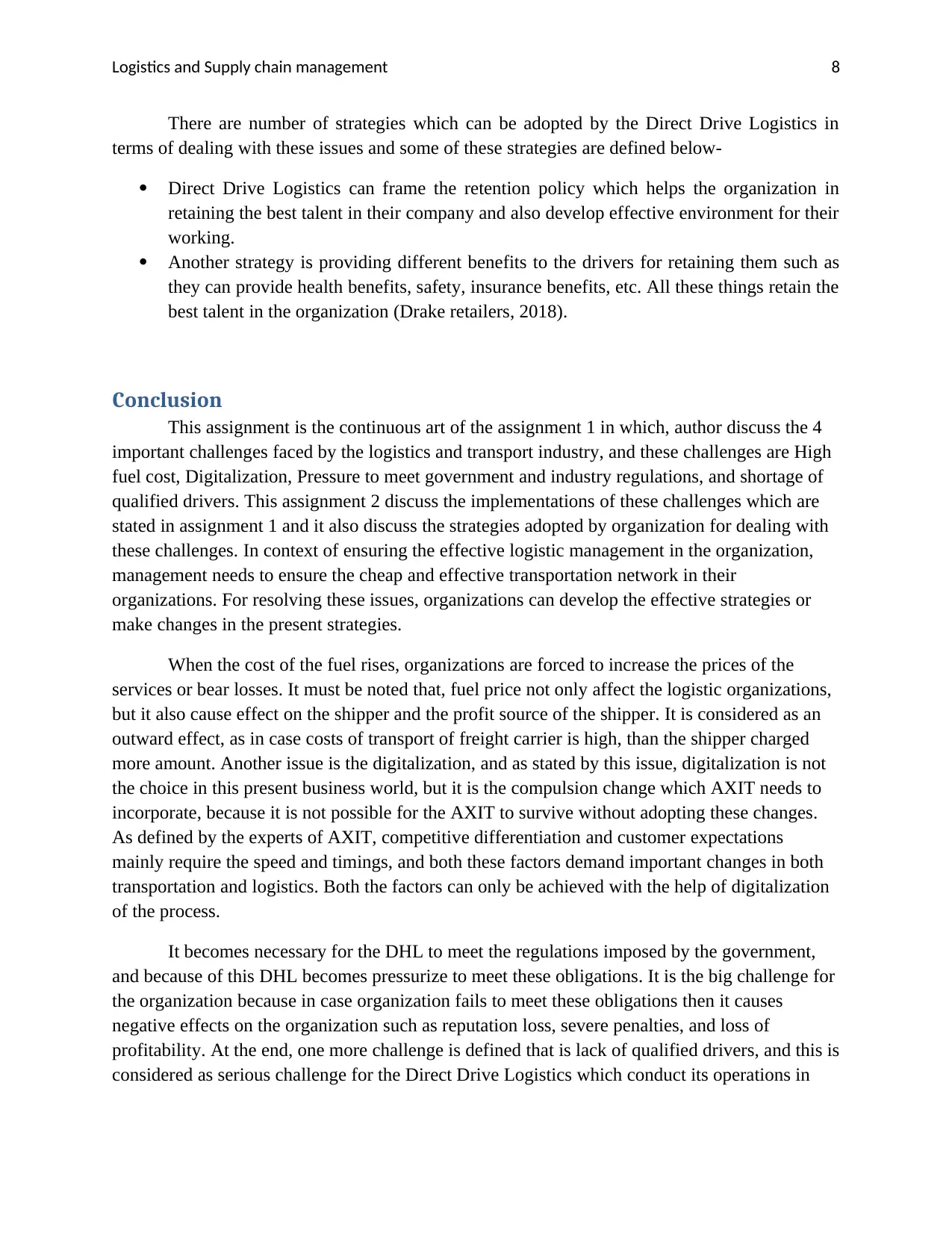
Logistics and Supply chain management 8
There are number of strategies which can be adopted by the Direct Drive Logistics in
terms of dealing with these issues and some of these strategies are defined below-
Direct Drive Logistics can frame the retention policy which helps the organization in
retaining the best talent in their company and also develop effective environment for their
working.
Another strategy is providing different benefits to the drivers for retaining them such as
they can provide health benefits, safety, insurance benefits, etc. All these things retain the
best talent in the organization (Drake retailers, 2018).
Conclusion
This assignment is the continuous art of the assignment 1 in which, author discuss the 4
important challenges faced by the logistics and transport industry, and these challenges are High
fuel cost, Digitalization, Pressure to meet government and industry regulations, and shortage of
qualified drivers. This assignment 2 discuss the implementations of these challenges which are
stated in assignment 1 and it also discuss the strategies adopted by organization for dealing with
these challenges. In context of ensuring the effective logistic management in the organization,
management needs to ensure the cheap and effective transportation network in their
organizations. For resolving these issues, organizations can develop the effective strategies or
make changes in the present strategies.
When the cost of the fuel rises, organizations are forced to increase the prices of the
services or bear losses. It must be noted that, fuel price not only affect the logistic organizations,
but it also cause effect on the shipper and the profit source of the shipper. It is considered as an
outward effect, as in case costs of transport of freight carrier is high, than the shipper charged
more amount. Another issue is the digitalization, and as stated by this issue, digitalization is not
the choice in this present business world, but it is the compulsion change which AXIT needs to
incorporate, because it is not possible for the AXIT to survive without adopting these changes.
As defined by the experts of AXIT, competitive differentiation and customer expectations
mainly require the speed and timings, and both these factors demand important changes in both
transportation and logistics. Both the factors can only be achieved with the help of digitalization
of the process.
It becomes necessary for the DHL to meet the regulations imposed by the government,
and because of this DHL becomes pressurize to meet these obligations. It is the big challenge for
the organization because in case organization fails to meet these obligations then it causes
negative effects on the organization such as reputation loss, severe penalties, and loss of
profitability. At the end, one more challenge is defined that is lack of qualified drivers, and this is
considered as serious challenge for the Direct Drive Logistics which conduct its operations in
There are number of strategies which can be adopted by the Direct Drive Logistics in
terms of dealing with these issues and some of these strategies are defined below-
Direct Drive Logistics can frame the retention policy which helps the organization in
retaining the best talent in their company and also develop effective environment for their
working.
Another strategy is providing different benefits to the drivers for retaining them such as
they can provide health benefits, safety, insurance benefits, etc. All these things retain the
best talent in the organization (Drake retailers, 2018).
Conclusion
This assignment is the continuous art of the assignment 1 in which, author discuss the 4
important challenges faced by the logistics and transport industry, and these challenges are High
fuel cost, Digitalization, Pressure to meet government and industry regulations, and shortage of
qualified drivers. This assignment 2 discuss the implementations of these challenges which are
stated in assignment 1 and it also discuss the strategies adopted by organization for dealing with
these challenges. In context of ensuring the effective logistic management in the organization,
management needs to ensure the cheap and effective transportation network in their
organizations. For resolving these issues, organizations can develop the effective strategies or
make changes in the present strategies.
When the cost of the fuel rises, organizations are forced to increase the prices of the
services or bear losses. It must be noted that, fuel price not only affect the logistic organizations,
but it also cause effect on the shipper and the profit source of the shipper. It is considered as an
outward effect, as in case costs of transport of freight carrier is high, than the shipper charged
more amount. Another issue is the digitalization, and as stated by this issue, digitalization is not
the choice in this present business world, but it is the compulsion change which AXIT needs to
incorporate, because it is not possible for the AXIT to survive without adopting these changes.
As defined by the experts of AXIT, competitive differentiation and customer expectations
mainly require the speed and timings, and both these factors demand important changes in both
transportation and logistics. Both the factors can only be achieved with the help of digitalization
of the process.
It becomes necessary for the DHL to meet the regulations imposed by the government,
and because of this DHL becomes pressurize to meet these obligations. It is the big challenge for
the organization because in case organization fails to meet these obligations then it causes
negative effects on the organization such as reputation loss, severe penalties, and loss of
profitability. At the end, one more challenge is defined that is lack of qualified drivers, and this is
considered as serious challenge for the Direct Drive Logistics which conduct its operations in
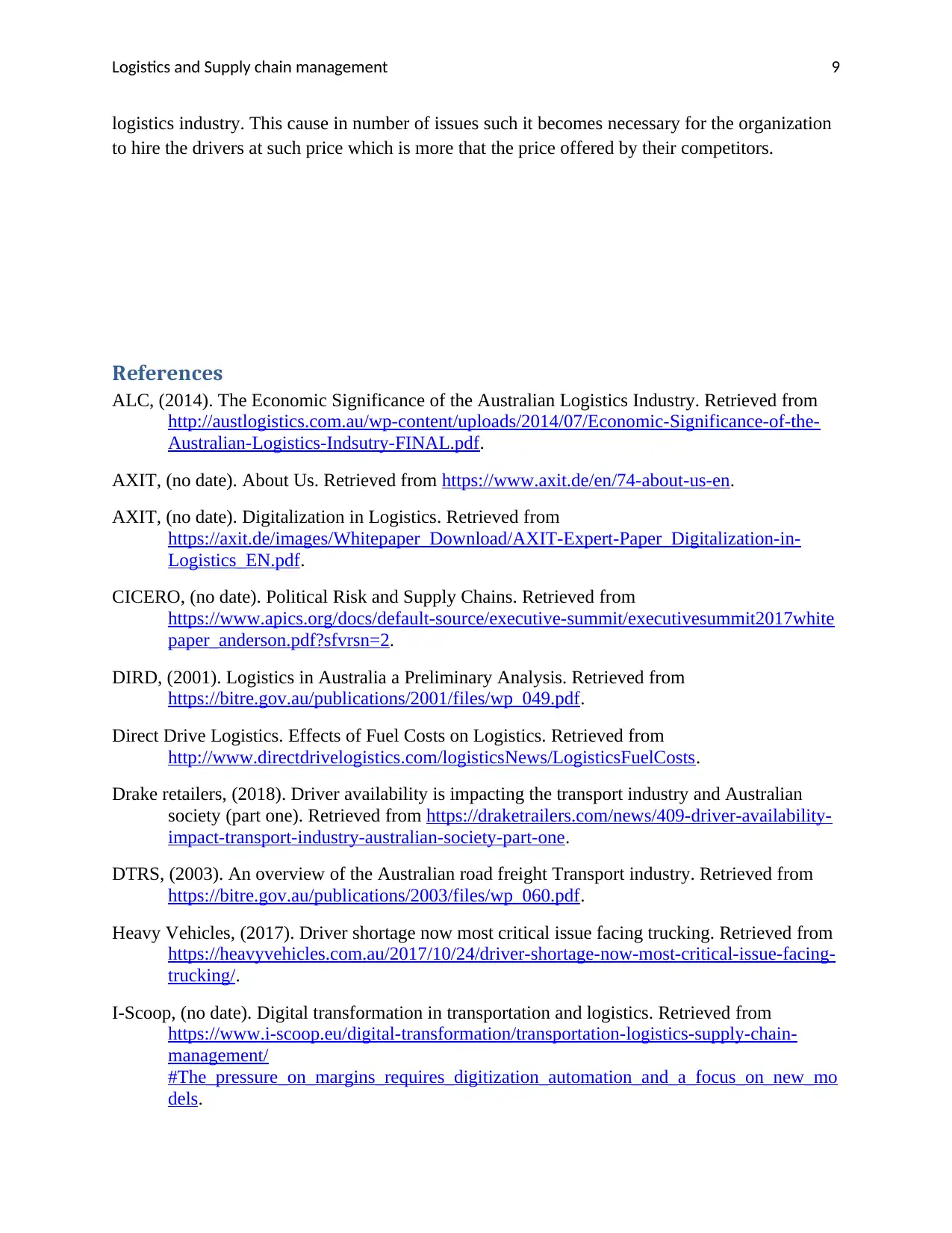
Logistics and Supply chain management 9
logistics industry. This cause in number of issues such it becomes necessary for the organization
to hire the drivers at such price which is more that the price offered by their competitors.
References
ALC, (2014). The Economic Significance of the Australian Logistics Industry. Retrieved from
http://austlogistics.com.au/wp-content/uploads/2014/07/Economic-Significance-of-the-
Australian-Logistics-Indsutry-FINAL.pdf.
AXIT, (no date). About Us. Retrieved from https://www.axit.de/en/74-about-us-en.
AXIT, (no date). Digitalization in Logistics. Retrieved from
https://axit.de/images/Whitepaper_Download/AXIT-Expert-Paper_Digitalization-in-
Logistics_EN.pdf.
CICERO, (no date). Political Risk and Supply Chains. Retrieved from
https://www.apics.org/docs/default-source/executive-summit/executivesummit2017white
paper_anderson.pdf?sfvrsn=2.
DIRD, (2001). Logistics in Australia a Preliminary Analysis. Retrieved from
https://bitre.gov.au/publications/2001/files/wp_049.pdf.
Direct Drive Logistics. Effects of Fuel Costs on Logistics. Retrieved from
http://www.directdrivelogistics.com/logisticsNews/LogisticsFuelCosts.
Drake retailers, (2018). Driver availability is impacting the transport industry and Australian
society (part one). Retrieved from https://draketrailers.com/news/409-driver-availability-
impact-transport-industry-australian-society-part-one.
DTRS, (2003). An overview of the Australian road freight Transport industry. Retrieved from
https://bitre.gov.au/publications/2003/files/wp_060.pdf.
Heavy Vehicles, (2017). Driver shortage now most critical issue facing trucking. Retrieved from
https://heavyvehicles.com.au/2017/10/24/driver-shortage-now-most-critical-issue-facing-
trucking/.
I-Scoop, (no date). Digital transformation in transportation and logistics. Retrieved from
https://www.i-scoop.eu/digital-transformation/transportation-logistics-supply-chain-
management/
#The_pressure_on_margins_requires_digitization_automation_and_a_focus_on_new_mo
dels.
logistics industry. This cause in number of issues such it becomes necessary for the organization
to hire the drivers at such price which is more that the price offered by their competitors.
References
ALC, (2014). The Economic Significance of the Australian Logistics Industry. Retrieved from
http://austlogistics.com.au/wp-content/uploads/2014/07/Economic-Significance-of-the-
Australian-Logistics-Indsutry-FINAL.pdf.
AXIT, (no date). About Us. Retrieved from https://www.axit.de/en/74-about-us-en.
AXIT, (no date). Digitalization in Logistics. Retrieved from
https://axit.de/images/Whitepaper_Download/AXIT-Expert-Paper_Digitalization-in-
Logistics_EN.pdf.
CICERO, (no date). Political Risk and Supply Chains. Retrieved from
https://www.apics.org/docs/default-source/executive-summit/executivesummit2017white
paper_anderson.pdf?sfvrsn=2.
DIRD, (2001). Logistics in Australia a Preliminary Analysis. Retrieved from
https://bitre.gov.au/publications/2001/files/wp_049.pdf.
Direct Drive Logistics. Effects of Fuel Costs on Logistics. Retrieved from
http://www.directdrivelogistics.com/logisticsNews/LogisticsFuelCosts.
Drake retailers, (2018). Driver availability is impacting the transport industry and Australian
society (part one). Retrieved from https://draketrailers.com/news/409-driver-availability-
impact-transport-industry-australian-society-part-one.
DTRS, (2003). An overview of the Australian road freight Transport industry. Retrieved from
https://bitre.gov.au/publications/2003/files/wp_060.pdf.
Heavy Vehicles, (2017). Driver shortage now most critical issue facing trucking. Retrieved from
https://heavyvehicles.com.au/2017/10/24/driver-shortage-now-most-critical-issue-facing-
trucking/.
I-Scoop, (no date). Digital transformation in transportation and logistics. Retrieved from
https://www.i-scoop.eu/digital-transformation/transportation-logistics-supply-chain-
management/
#The_pressure_on_margins_requires_digitization_automation_and_a_focus_on_new_mo
dels.
⊘ This is a preview!⊘
Do you want full access?
Subscribe today to unlock all pages.

Trusted by 1+ million students worldwide
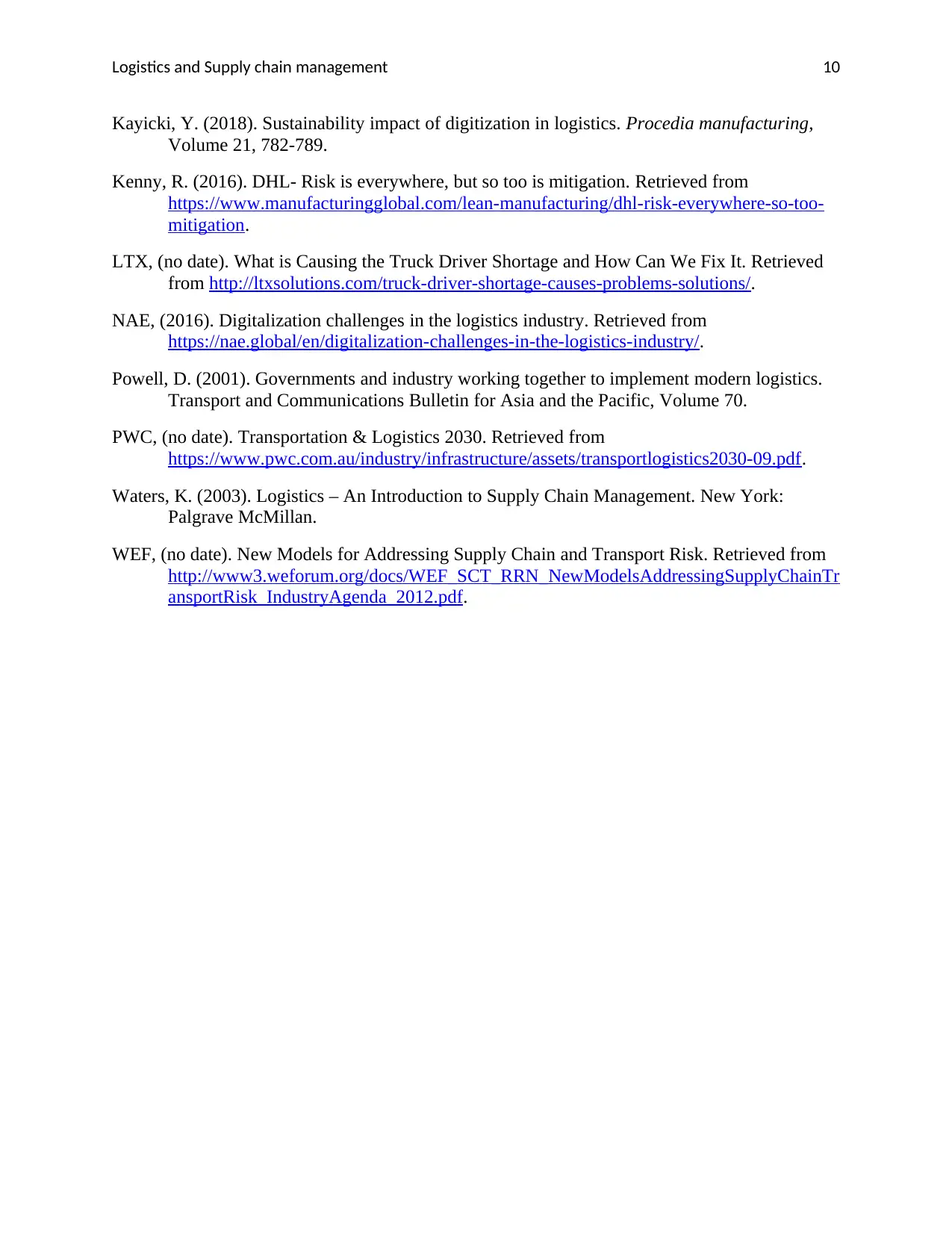
Logistics and Supply chain management 10
Kayicki, Y. (2018). Sustainability impact of digitization in logistics. Procedia manufacturing,
Volume 21, 782-789.
Kenny, R. (2016). DHL- Risk is everywhere, but so too is mitigation. Retrieved from
https://www.manufacturingglobal.com/lean-manufacturing/dhl-risk-everywhere-so-too-
mitigation.
LTX, (no date). What is Causing the Truck Driver Shortage and How Can We Fix It. Retrieved
from http://ltxsolutions.com/truck-driver-shortage-causes-problems-solutions/.
NAE, (2016). Digitalization challenges in the logistics industry. Retrieved from
https://nae.global/en/digitalization-challenges-in-the-logistics-industry/.
Powell, D. (2001). Governments and industry working together to implement modern logistics.
Transport and Communications Bulletin for Asia and the Pacific, Volume 70.
PWC, (no date). Transportation & Logistics 2030. Retrieved from
https://www.pwc.com.au/industry/infrastructure/assets/transportlogistics2030-09.pdf.
Waters, K. (2003). Logistics – An Introduction to Supply Chain Management. New York:
Palgrave McMillan.
WEF, (no date). New Models for Addressing Supply Chain and Transport Risk. Retrieved from
http://www3.weforum.org/docs/WEF_SCT_RRN_NewModelsAddressingSupplyChainTr
ansportRisk_IndustryAgenda_2012.pdf.
Kayicki, Y. (2018). Sustainability impact of digitization in logistics. Procedia manufacturing,
Volume 21, 782-789.
Kenny, R. (2016). DHL- Risk is everywhere, but so too is mitigation. Retrieved from
https://www.manufacturingglobal.com/lean-manufacturing/dhl-risk-everywhere-so-too-
mitigation.
LTX, (no date). What is Causing the Truck Driver Shortage and How Can We Fix It. Retrieved
from http://ltxsolutions.com/truck-driver-shortage-causes-problems-solutions/.
NAE, (2016). Digitalization challenges in the logistics industry. Retrieved from
https://nae.global/en/digitalization-challenges-in-the-logistics-industry/.
Powell, D. (2001). Governments and industry working together to implement modern logistics.
Transport and Communications Bulletin for Asia and the Pacific, Volume 70.
PWC, (no date). Transportation & Logistics 2030. Retrieved from
https://www.pwc.com.au/industry/infrastructure/assets/transportlogistics2030-09.pdf.
Waters, K. (2003). Logistics – An Introduction to Supply Chain Management. New York:
Palgrave McMillan.
WEF, (no date). New Models for Addressing Supply Chain and Transport Risk. Retrieved from
http://www3.weforum.org/docs/WEF_SCT_RRN_NewModelsAddressingSupplyChainTr
ansportRisk_IndustryAgenda_2012.pdf.
1 out of 10
Related Documents
Your All-in-One AI-Powered Toolkit for Academic Success.
+13062052269
info@desklib.com
Available 24*7 on WhatsApp / Email
![[object Object]](/_next/static/media/star-bottom.7253800d.svg)
Unlock your academic potential
Copyright © 2020–2025 A2Z Services. All Rights Reserved. Developed and managed by ZUCOL.





